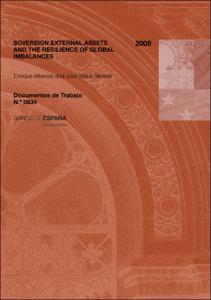Registro completo de metadatos
| Campo DC | Valor |
|---|---|
| dc.contributor.author | Alberola, Enrique |
| dc.contributor.author | Serena, José María |
| dc.date.accessioned | 2019-08-10T17:53:14Z |
| dc.date.available | 2019-08-10T17:53:14Z |
| dc.date.issued | 2009-02-02 |
| dc.identifier.issn | ISSN: 0213-2710 (en papel) |
| dc.identifier.issn | ISSN: 1579-8666 (en línea) |
| dc.identifier.uri | https://repositorio.bde.es/handle/123456789/6967 |
| dc.description.abstract | Sovereign external assets (SEAs) comprise foreign exchange reserves and sovereign wealth funds (SWFs). The global stock of reserves reached 7 $trn in the second quarter of 2008, but data on SWF are rather elusive. Our estimation puts the SWFs at around 2,5 $trn dollars by 2007 and in the last years they have grown at a high pace, fostered by high commodity prices. Therefore, SEAs have surpassed the 10 $trn mark (around 5% of global assets and 15% of global GDP). This paper argues that reserves and SWF assets should be jointly considered for the assessment of global imbalances. Both are official capital outflows from developing to developed countries, both hinder internal adjustment in current account surplus countries, both help to cover the financing needs of deficit countries, in particular in the US, and, therefore, both contribute to sustain global imbalances. The importance of SEAs in financing the external imbalances of the US has been widely recognised but scantly measured. Our rule-of-thumb calculations suggests that they have greatly increased their importance in the last years, having surpassed the US$ trillion increase in 2007 |
| dc.description.abstract | relative to US financing needs, this amount represents around a 135% and 50% of net and gross needs, respectively, in 2007. Reserves have in the last years contributed 80% and SWFs 20%.Looking ahead, two main conclusions can be put forward: 1) the relative importance SWFs in the financing of the US deficits and global imbalances is set to increase (also relative to reserves), but this is conditional to commodity prices remaining at high levels. On the one hand, the economic motivation of SWFs -intertemporal smoothing- is more palatable than that of reserves (exchange rate management), despite political concerns on SWFs |
| dc.description.abstract | on the other hand, SWFs do not have significant internal costs, contrary to reserves, whose monetary and fiscal costs are increasing in the margin.. |
| dc.format.extent | 33 p. : tab., gráf. |
| dc.language.iso | en |
| dc.publisher | Banco de España |
| dc.relation.ispartof | Documentos de Trabajo / Banco de España, 0834 |
| dc.rights | Reconocimiento-NoComercial-CompartirIgual 4.0 Internacional (CC BY-NC-SA 4.0) |
| dc.rights | In Copyright - Non Commercial Use Permitted |
| dc.rights.uri | https://creativecommons.org/licenses/by-nc-sa/4.0/deed.es_ES |
| dc.rights.uri | http://rightsstatements.org/vocab/InC-NC/1.0/ |
| dc.subject | International reserves |
| dc.subject | Sovereign wealth funds |
| dc.subject | Global imbalances |
| dc.subject | Exchange rates |
| dc.title | Sovereign external assets and the resilience of global imbalances |
| dc.type | Documento de trabajo |
| dc.identifier.bdebib | 000221158 |
| dc.identifier.bdepub | DTRA-200834-eng |
| dc.subject.bde | Bancos centrales y otras autoridades monetarias |
| dc.subject.bde | Política monetaria |
| dc.subject.bde | Blanqueo de capitales |
| dc.publisher.bde | Madrid : Banco de España, 2008 |
| dc.subject.jel | E58 |
| dc.subject.jel | F21 |
| dc.subject.jel | F36 |
| dc.subject.jel | G15 |












